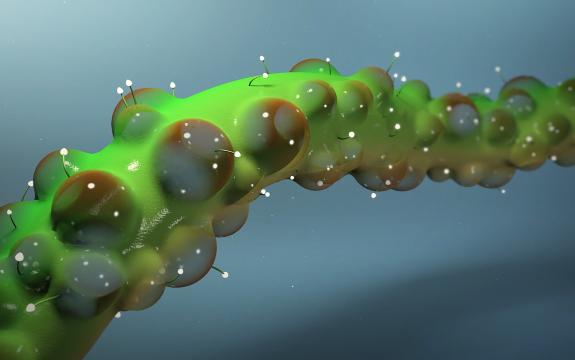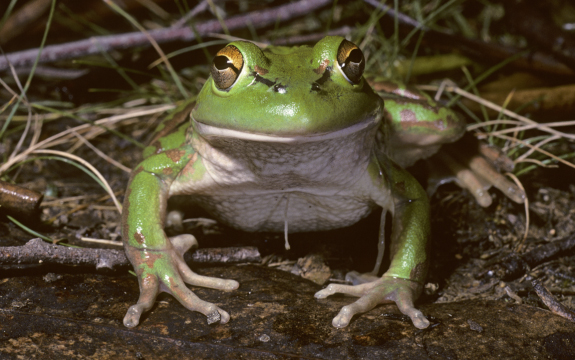Growling Grass Frog animation creates awareness of endangered species

In Summary
- Animation raises awareness to protect the Growling Grass Frog from extinction
- Shaped like a branch, the digital object’s surface has a similar texture to the frog’s skin
- Bubbles replicate the vocal sacs found on a frog’s neck that bulge when they call
James Berrett, Innovation Fellow at the Swinburne Innovation Precinct and Lecturer in Digital Media Design at Swinburne, and student Jennifer Dudgeon have created a powerful digital animation to create awareness of the endangered Growling Grass Frog.
Driven by the calls of the frog, it explores how sounds can be visualised. It is inspired by the frog’s characteristics and habitat. The Victorian native Growling Grass Frog is an endangered species due to rapid loss of habitat caused by the expansion of urban development around Melbourne’s fringe.
Growling Grass Frog animation by James Berrett and student Jennifer Dudgeon
“During our research we came across interesting visualisations that used three dimensional spheres driven by audio. The spheres reminded us of frog vocal sacs which expand when they call,” explains Ms Dudgeon.
“The animation Visual Sounds of the Amazon significantly influenced the direction of the design. It’s quite abstract in the way it represents bird calls by using motion, form, textures and colours. I wanted to create something similar to represent the Growling Grass Frog, not too obvious in its form, by adapting similar qualities and textures,” Ms Dudgeon says.
The design of the animation was heavily influenced by the physical characteristics of the Growling Grass Frog and its habitat. Shaped like a branch, the digital object’s surface has a similar texture to the frog’s skin. Predominantly green it gradually turns into a sandy brown underneath the branch.

Growling Grass Frog (Litoria raniformis), image by Peter Robertson
“The surface is filled with weeds and bubbles which react to the sound of Growling Grass Frogs calling. These bubbles replicate the vocal sacs found on a frog’s neck that bulge when they call,” says Ms Dudgeon.
“The animated bubbles on the skin are designed to look like they are a part of the branch, creating a bulge in the surface. The bubbles begin to turn translucent as they stretch, just like a frog’s vocal sac. The blue background represents its habitat as they are mainly found near or in water,” she says.
The call sounds of the Growling Grass Frog were provided by Melbourne Water and their Water Watch Frog Census program.
The work featured at Melbourne Knowledge Week this year to raise awareness about the plight of the once prolific Growling Grass Frog around Melbourne and its environs.
The Growling Grass Frog or Litoria raniformis is listed as a threatened species under the Commonwealth Environment Protection and Biodiversity Conservation Act 1999 and the Victorian Flora and Fauna Guarantee Act 1988. It’s also listed on the Department of the Environment & Energy - Species Profile and Threats Database.
It was once one of the most common frogs in south-eastern Australia but has suffered substantial decline in recent decades.

